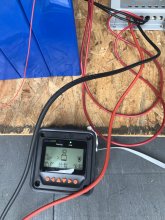SmartSolar vs BlueSolar -
In a nutshell......
Is the only bluetooth difference Internal vs External (dongle) Bluetooth ?
As far as I can tell from the specs, yes. Perhaps one of the Victron Pros could confirm...
SmartSolar vs BlueSolar -
In a nutshell......
Is the only bluetooth difference Internal vs External (dongle) Bluetooth ?
That is definitely a difference. Here's Victron's detailed comparison sheet for all models:
I agree with the concept, but there is a voltage difference. "floating" at absorption and floating at float have different long-term implications, i.e., reduced battery life.
Because after about 30-60 minutes, your LFP battery will be full at the absorption voltage.
If that allows you the ability to override the default T1 value permitting a maximum DV duration of 15-120 minutes, you're good.
Ideal (for fully charged typical LFP specs):
CC to 3.65V
CV @3.65 to 0.05C tail current cut-off (14A for a 280Ah cell)
Float at 3.4
With Victron, I get to specify both absorption time and tail current. The first one hit triggers float. This is typical of Tier-1 products.
If both aren't available, control of either means of charge termination means is acceptable. CV time is the most common, and it's fine.
I'm not positive the Epever is really ready for LiFePO4 yet.
When you read their literature it seems to skirt around the direct mention of LiFePO4 batteries?
Specifications
Nominal System:12/24/36/48VDC or Auto
Battery Input:8V~68V
Battery Type:Sealed(Default)/Gel/Flooded/User
Battery fuse:80A/58V
Rated charge current and discharge current:60A
Rated charge Power:750W/12V 1500W/24V 2250W/36V 3000W/48V
Max. PV open:150V
Temperature compens:-3mV/℃/2V(Default)
Grounding:Common NEGATIVE grounding
Enclosure:IP20
Pollution degreeD2
Dimension:340×236×119mm
Weight:4.5kg
In one of his YT videos, I believe Will (forum admin) said Victron controllers ran very hot.
Ideal (for fully charged typical LFP specs):
CC to 3.65V
CV @3.65 to 0.05C tail current cut-off (14A for a 280Ah cell)
Float at 3.4
With Victron, I get to specify both absorption time and tail current. The first one hit triggers float. This is typical of Tier-1 products.
If both aren't available, control of either means of charge termination means is acceptable. CV time is the most common, and it's fine.
I'm not positive the Epever is really ready for LiFePO4 yet.
When you read their literature it seems to skirt around the direct mention of LiFePO4 batteries?
Specifications
Nominal System:12/24/36/48VDC or Auto
Battery Input:8V~68V
Battery Type:Sealed(Default)/Gel/Flooded/User
Battery fuse:80A/58V
Rated charge current and discharge current:60A
Rated charge Power:750W/12V 1500W/24V 2250W/36V 3000W/48V
Max. PV open:150V
Temperature compens:-3mV/℃/2V(Default)
Grounding:Common NEGATIVE grounding
Enclosure:IP20
Pollution degreeD2
Dimension:340×236×119mm
Weight:4.5kg
Here is a direct quote from an email I received from Epever Support:
‘That presentation was made in 2018, it supports lithium battery now.
To be sure you get the new version, you can check with the vendor and ask them whether the label on the package box has
i. 12/24/36/48
or
ii 12/24/36/48/Li
The 'Li' means it supports lithium battery.’
So if you want to purchase a new Epever SCC with support for Lithium battery, you need to make certain your box label ends in ‘/Li’
It’s very confusing that they did not introduce a new product code or model.
I suspect it was a running change and all older Epever AN-Series do not fully support Lithium batteries (boxes without ‘/Li’ label) and all newer Epever-Series do support Lithium batteries (and have boxes with the ‘/Li’ label...).
This is a reason to only purchase Epever SCCs from a vendor with no-cost return rights if you have a lithium battery...
This is the current "Contact" information for Epever at the Epever.com website........
Beijing Headquarter
BEIJING EPSOLAR TECHNOLOGY CO., LTD.
Add:BLDG#18,CO.PARK,NO.8HEYING ROAD,CHANGPINGDISTRICT,BEIJING,CHINA.102200.
Tel:+86-10-82894112
Fax:+86-10-82894882
Sales enquiry:info@epsolarpv.com
Technical support:support@epsolarpv.com
Good Luck. This was after Googling 'Epever USA"
I was just shopping for a CC when I read some horror stories at this forum about EPEVER (lack of) support.
Some said support involves sending the units back to China ($200) at your expense for service?
May have to settle for a less capable (Amps/Volts) controller from Victron.
But in all fairness, I also went to the Victron website and it's based in the Netherlands.
No clear cut USA based office to call and get support within the continental USA.
Support seems equally difficult to obtain.
You buy it, you try it, you fry it, you cry it
I’ve found Epever to be far more responsive in my requests to them than Victron thus far.
If local technical and customer support is a top priority for you, you should only purchase from a US-based company (or a foreign company with a well-established US support organization)...

you do have to be careful and take your time getting familiar with it, but settings are straight-forward, and the manual covered what I needed to know. I used the lfp conservative numbers documented in the forum resources download. I’ve seen as high as 34.86a. And it’s a completely overcast day.
View attachment 41896
Tracer 4215bn negative grounded. Currently charging a 12v battery pack, but final install will be a 24v system. This is capable of both.Nice!
Which model do you have (and what voltage LFP battery are you charging)?
FM60/80 are good controllers. I helped my neighbor configure his 2X FM80 and concur they perform as desired.
One of his has been buggy. It gets stuck in the "charged" mode between absorption termination and float. It falls below float and even below re-bulk where it should trigger a whole new charge cycle. It's done this a few times. Once he wired the second one into the system, it hasn't happened with either.
One other forum user had this problem, and you can find a handful of accounts of similar behavior.
@uptopsolar - any input on that?



